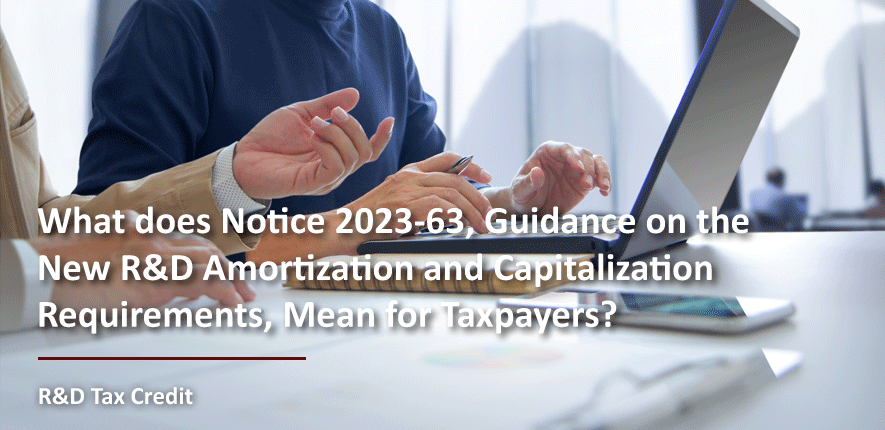
Sep 21, 2023 What does Notice 2023-63, Guidance on the New R&D Amortization and Capitalization Requirements, Mean for Taxpayers?
On September 8, 2023, the Internal Revenue Service (“IRS”) and Department of the Treasury (“Treasury”) released an advance version of Notice 2023-63. This Notice provides interim guidance intended to clarify the amortization and capitalization of specified research and experimental (“SRE”) expenditures under Section 174, amended by the Tax Cuts and Jobs Act (TCJA) in 2017. Proposed regulations provide rules consistent with the guidance for tax years ending after September 8, 2023. Until those regulations are provided, tax professionals can rely on interim guidance.
While the interim guidance is helpful to move forward as it has provided necessary clarification, the issuance of the interim guidance likely means that the repeal of Section 174 will not occur in 2023.
Review of the history and how the rule changes to Section 174 came about is helpful. When the announcement of the changes to Section 174 was made with the TCJA, most professionals thought it would get repealed before it came into effect. The provision was not set to start until 2022. The question becomes, why would you pass a bill with a provision expected to be repealed? The answer: budget reconciliation. The TCJA was enacted under a process known as reconciliation. Among other things, reconciliation requires that the bill does not increase the deficit beyond the 10-year budget window. The change in Section 174 was a revenue generator, which reduced the overall cost of the bill to get it passed.
Those opposed to the bill and change to Section 174 were assured that the law would be repealed sometime in the next five years before it was supposed to take effect in 2022. Numerous bills have been brought before Congress to repeal Section 174 this year; such as the CREATE JOBS Act (S.314) and The Build It in America Act (H.R. 3939). While bipartisan support for the following bills H.R.2673 and S.866, both repealing section 174, were encouraging, none of these have passed.
With the released interim guidance, the consensus is that if Section 174 would be repealed, it would not be until 2025 at the earliest. With an election year on the horizon, relief does not seem to be headed our way anytime soon.
Notice 2023-63 sheds light on what costs will qualify as SRE and how to treat short years, acquisitions and dispositions. Key definitions or interim guidance on the above from the 45-page notice are:
- SRE is defined as “in connection with the taxpayer’s trade or business.”
this is a broader definition than “in carrying on” a trade or business. - If property is disposed, abandoned, or retired, an immediate deduction will not be allowed. New section 174(d) requires that the assets still be amortized over the five-year period.
- Short taxable years. A short taxable year will not be considered a “full tax year” and any SRE must be amortized over a full 60-month period.
- Allocation method. SRE expenditure costs must be allocated. Allocation methods can be different for each type of cost, but the type of method used for each cost must be consistent.
- Further identification of SRE expenditures.
The list is exhaustive, but key costs were identified as SREs.
• Labor costs
• Materials and Supplied costs
• Costly recovery allowance
• Patent costs
• Certain operation and management costs
• Travel costs
There are numerous other provisions providing interim guidance on handling the effect of the changes to Section 174, beyond this article. If a company’s activities meet the definition of an SRE, it is imperative they consult with their tax professionals before filing their tax returns. Unfortunately, the changes will undoubtedly increase a taxpayer’s tax liability.
What can taxpayers do if Section 174 is not repealed in the upcoming years? The only offset to the amortization that taxpayers can find some immediate relief is Section 41, the R&D tax credit. If you have not been taking the R&D tax credit because you were not taxable, the amortization rules will likely push you into a taxable position. The R&D tax credit could offset the increased liability a company will be faced with in the upcoming years. While all Section 41 expenditures qualify as Section 174 SRE expenditures, not all Section 174 SRE expenditures will qualify as Section 41 expenditures. As defined, SRE expenditures have a more expansive reach since they merely have to be in “connection” to the trade or business while Section 41 expenditures need to be related to a particular trade or business of a taxpayer being carried on.
Author: Lacey J.S. Robb, JD, LLM Taxation. Principal, Northeast Practice Leader
Section 174 is applicable to all taxpayer entities, regardless of their industry or business size, that accrue eligible research expenses. The R&D Tax Credit is a federal incentive offered to companies that develop, design, or improve products, processes, formulas, or software. Numerous activities and processes qualify for the research credit. The R&D tax credit can be claimed by any company for both current and prior tax years. Are you eligible? » Contact our R&D Tax Credit experts


